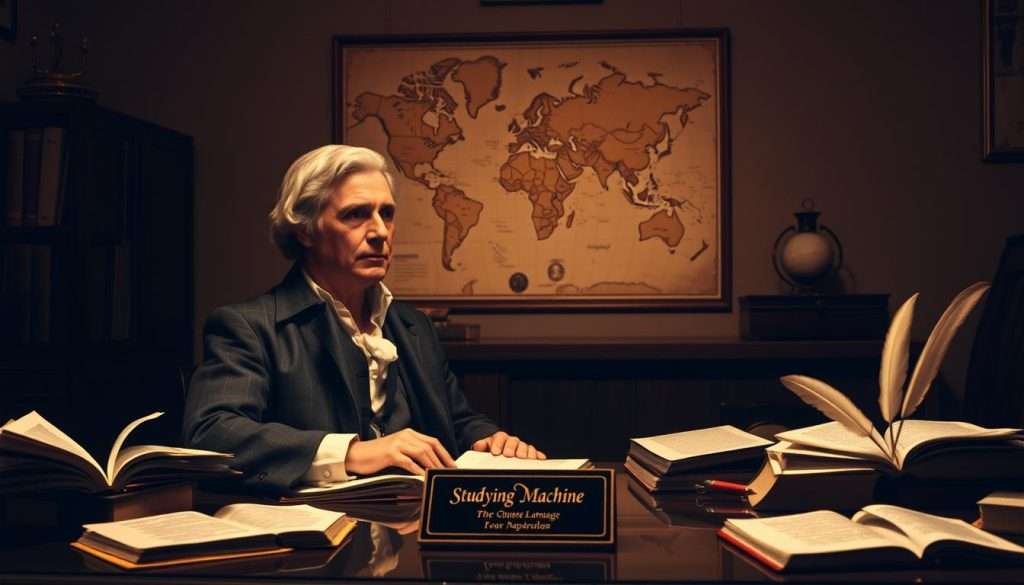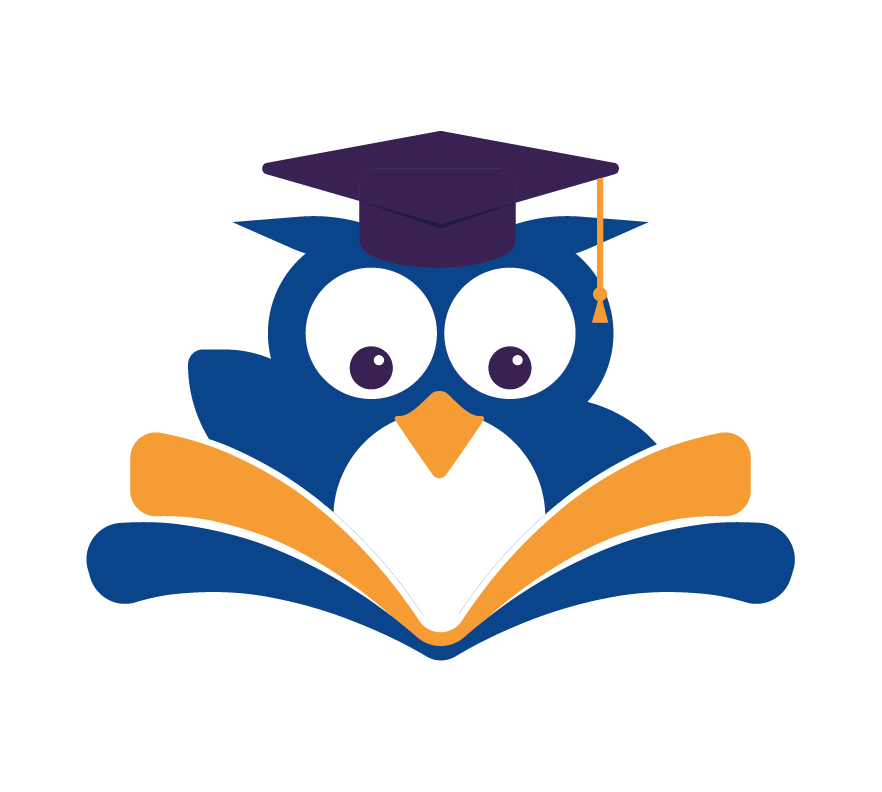Imagine mastering many subjects with ease, just like a true Renaissance man. Thomas Jefferson, one of America’s founding fathers, was a polymath. His learning approach can still guide us today.
Jefferson was a statesman, scientist, and philosopher. His insatiable curiosity and effective learning strategies helped him excel in many areas. By learning from him, we can make learning more fun and effective.
So, how can we use Jefferson’s methods for our own learning? By adopting his strategies, we can learn more efficiently and stay motivated. Let’s dive into some key strategies that made Jefferson a true polymath.
Key Takeaways
- Discover the importance of curiosity in the learning process
- Explore Jefferson’s effective strategies for mastering multiple disciplines
- Learn how to apply historical techniques to modern learning challenges
- Understand the role of self-directed learning in achieving success
- Find out how to stay motivated and engaged in your learning journey
The Intellectual Legacy of Thomas Jefferson
Thomas Jefferson’s legacy goes beyond being a founding father. His dedication to education still inspires us today. Let’s dive into his approach to learning and education.
A Founding Father’s Commitment to Knowledge
Jefferson’s intellectual achievements were not by chance. They came from a deep and ongoing love for learning.
Jefferson’s Remarkable Intellectual Achievements
Jefferson was a true polymath. He excelled in law, literature, science, and architecture. His work, like the Declaration of Independence, greatly influenced American thought.
The Connection Between Learning and Liberty
For Jefferson, learning was more than personal growth. It was linked to freedom. He saw an educated public as key to democracy’s success.
Jefferson’s Educational Background
Knowing about Jefferson’s education helps us understand his learning philosophy.
Formal Education and Self-Teaching Balance
Jefferson’s education was a blend of formal schooling and self-study. He went to the College of William & Mary and studied law under George Wythe.
Key Influences on Jefferson’s Learning Approach
The Enlightenment thinkers shaped Jefferson’s views on education. Locke and Rousseau’s ideas had a big impact on him.
| Aspect | Jefferson’s Approach | Influence |
|---|---|---|
| Education | Balanced formal and self-directed learning | College of William & Mary, self-study |
| Liberty | Believed education was crucial for democracy | Enlightenment thinkers |
| Curiosity | Encouraged lifelong learning and inquiry | Personal trait and Enlightenment ideas |
Jefferson’s Philosophy of Lifelong Education
Jefferson’s educational views were shaped by the Enlightenment. This movement valued human reason, individual freedom, and the quest for knowledge.
The Enlightenment Influence on Jefferson’s Learning
The Enlightenment deeply influenced Jefferson’s education views. He stressed the need for reason, evidence, and critical thinking. He thought people should question and analyze information, not just accept it.
Reason, Evidence, and Critical Thinking
Jefferson prized knowledge based on evidence and encouraged critical thinking. This helped people make smart choices and tackle complex problems.
The Pursuit of Useful Knowledge
He also pushed for practical, real-world learning. This idea still shapes education today.
Jefferson’s Core Educational Principles
Jefferson’s education philosophy centered on key principles. One was freedom of inquiry and independent thought. He believed in letting people explore and form their own opinions.
Freedom of Inquiry and Independent Thought
This idea was crucial to Jefferson’s education vision. It allowed for critical thinking and informed decision-making.
Education as a Cornerstone of Democracy
Jefferson also saw education as vital for democracy. He believed an educated public was key to a healthy democracy.
Jefferson’s educational ideas still guide us today. They highlight the value of lifelong learning and its role in society.
How to Learn Like Thomas Jefferson: Core Principles
To learn like Thomas Jefferson, we need to follow his key principles. These include curiosity, practical application, and thinking across different subjects. Jefferson’s learning style was driven by curiosity and a focus on using knowledge in real life.
Cultivating Insatiable Curiosity
Jefferson’s curiosity led him to study and explore a lot. To be curious like him, we should ask better questions and dive into different topics.
Asking Better Questions
Asking the right questions is key to learning. Jefferson was great at asking deep questions. He talked to experts and had discussions to learn more.
Exploring Diverse Subjects
Jefferson was interested in many areas, like politics, literature, science, and architecture. By exploring different subjects, we can gain a deeper understanding of the world.
Applying Knowledge to Real-World Problems
Jefferson was not just a thinker; he was a problem solver. He used his knowledge to solve real problems and find new solutions.
Jefferson’s Problem-Solving Methodology
Jefferson solved problems by thinking critically, being creative, and trying new things. By using this method, we can solve complex problems better.
Embracing Interdisciplinary Learning
Jefferson’s learning was all about connecting different subjects. He saw how various fields of knowledge were linked and used these connections to understand the world.
Connecting Different Fields of Knowledge
By seeing how different subjects are connected, we can understand complex issues better. Jefferson’s ability to link different fields was a key part of his innovative thinking.
By following these core principles, we can learn like Thomas Jefferson. As he said,
“I like the dreams of the future better than the history of the past.”
This forward-thinking approach to learning is what we should aim for.
Jefferson’s Reading Methodology
Jefferson’s reading method was all about picking the right books and sticking to a schedule. He didn’t just read to learn new things. He wanted to really understand different subjects.
Strategic Selection of Reading Materials
Jefferson was very careful about what he read. He didn’t just pick any book. He looked for books that matched his interests and goals.
Jefferson’s Criteria for Choosing Books
Jefferson wanted books that were both informative and thought-provoking. He was especially drawn to books on history, science, and philosophy. He considered the author’s reputation and how relevant the book was to today’s world.
Balancing Classics with Contemporary Works
Jefferson believed in reading both old and new books. He knew that classic works gave him a solid foundation. At the same time, he wanted to stay up-to-date with current events and ideas.

Jefferson’s Reading Schedule and Habits
Jefferson had a strict reading schedule. He set aside specific times each day to read. This helped him make progress through his vast library.
Creating Dedicated Reading Time
To follow Jefferson’s example, you should set aside time each day to read. It could be in the morning or before bed. Choose the time that works best for you.
Active Reading Techniques
Jefferson didn’t just read; he actively engaged with what he read. He took notes and summarized books to deepen his understanding and remember what he read.
Building a Personal Library Like Jefferson
Jefferson loved his library and carefully chose his books. He made sure his collection showed his wide range of interests.
Organizing Books by Subject Matter
Jefferson organized his books by topic. This made it easy for him to find what he needed. You can do the same by organizing your books by subject or genre.
Digital Library Management Inspired by Jefferson
In today’s world, we can use Jefferson’s ideas for organizing our digital libraries. Digital tools can help us categorize and manage our e-books, making reading more enjoyable.
| Reading Habit | Jefferson’s Approach | Modern Application |
|---|---|---|
| Selecting Reading Materials | Used specific criteria including author reputation and relevance | Use online reviews and recommendations to select books |
| Reading Schedule | Allocated dedicated time daily for reading | Schedule reading time in your daily planner or calendar |
| Library Organization | Organized books by subject matter | Use digital tools to categorize e-books by genre or subject |
The Jeffersonian Note-Taking System
Thomas Jefferson’s note-taking method was ahead of its time. It’s still useful today. His Commonplace Book system collected and organized information from many sources.
Mastering the Commonplace Book Method
Jefferson’s Commonplace Book was more than a notebook. It was a way to record and connect ideas. To start your own, pick a notebook or digital tool.
Setting Up Your Own Commonplace Book
- Select a notebook or digital tool that suits your preference.
- Develop an index to help you navigate your entries.
- Begin recording information that resonates with you.
What to Record and How to Record It
Record quotes, ideas, and insights that you find interesting. Use a consistent method for noting down the source and context.
Organizing and Categorizing Information
Jefferson was careful about organizing his notes. He used a classification system to categorize his entries.
Jefferson’s Classification System
Jefferson’s system involved categorizing information into broad topics and subtopics. This made it easy to find specific notes.
Cross-Referencing for Better Recall
- Create links between related entries.
- Use your index to cross-reference information.
Modern Applications of Jefferson’s Note-Taking
Jefferson’s methods were analog, but they work with digital tools too.
Digital Tools That Mimic Jefferson’s Methods
Tools like Evernote and Roam Research let you create a digital Commonplace Book.
Combining Handwritten and Digital Notes
Many people mix handwritten and digital notes. Try different methods to see what works best for you.
Jefferson’s Language Acquisition Techniques
Learning languages was a lifelong passion for Jefferson. He developed several techniques to aid in his endeavors. His approach to language learning is a valuable lesson for modern learners.
How Jefferson Mastered Multiple Languages
Jefferson’s mastery of multiple languages was rooted in his strong foundation in grammar and vocabulary. He believed in starting with the basics.
Starting with Grammar and Vocabulary Foundations
Jefferson focused on understanding the grammatical structures and building a robust vocabulary. This foundation allowed him to progress quickly in his language learning journey.
Translation as a Learning Tool
He also used translation as a tool to improve his language skills. He practiced by translating texts from one language to another.
Daily Practice and Immersion Strategies
Daily practice was a crucial element of Jefferson’s language learning strategy. He immersed himself in the language by reading, writing, and speaking it regularly.
Creating Immersive Learning Environments
Jefferson created immersive environments by surrounding himself with the language he was learning. This included reading literature, conversing with native speakers, and even maintaining a personal library with books in multiple languages.

He also employed a spaced repetition approach. This involved reviewing material at increasingly longer intervals to aid in long-term retention.
Applying Jefferson’s Language Learning Methods Today
Modern learners can apply Jefferson’s methods by leveraging contemporary resources. This includes language learning apps and online courses.
Modern Resources That Align with Jefferson’s Techniques
Today, there are numerous apps and online platforms that incorporate spaced repetition and immersive learning. This makes it easier to follow in Jefferson’s footsteps.
Setting Realistic Language Learning Goals
It’s also essential to set realistic goals, just as Jefferson did. This helps maintain motivation and track progress in language learning.
Time Management the Jeffersonian Way
Thomas Jefferson was a master of time management. He balanced his love for learning with everyday tasks. We can still learn from his daily routines and strategies today.
Jefferson’s Daily Schedule and Routines
Jefferson started his day early. He believed in making the most of his morning hours.
Morning Rituals for Productive Learning
His day began before dawn with quiet study. This morning ritual helped him focus on important tasks.
Allocating Time for Different Types of Study
He set aside specific times for reading, writing, and experiments. This balanced approach to study was key.
Balancing Intellectual Pursuits with Practical Matters
Jefferson knew how to balance his love for learning with daily life.
Integrating Learning into Daily Activities
He made learning part of his daily routine. For example, he read while traveling or talking to others.
Jefferson’s Approach to Avoiding Burnout
He also knew how to avoid burnout. He varied his activities and took breaks to relax and enjoy leisure.
| Time of Day | Activity | Benefit |
|---|---|---|
| Early Morning | Quiet Study | Sets a productive tone for the day |
| Late Morning | Reading and Writing | Advances knowledge and communication skills |
| Afternoon | Practical Experiments | Applies theoretical knowledge to real-world problems |
By using some of Jefferson’s time management tips, we can boost our productivity. We can also find a better balance between learning and daily tasks.
Learning Through Correspondence and Debate
Thomas Jefferson showed us the power of learning through writing and debate. This method helps us think deeply and see things from different angles. It makes us understand more about the world around us.
Jefferson’s Extensive Letter Writing Practice
Jefferson loved writing letters. It helped him sort out his thoughts and connect with others on a deeper level.
Using Writing to Clarify Thinking
Writing made Jefferson think more clearly. It helped him share his ideas in a way that others could understand.
Building a Network of Knowledge Exchange
Through his letters, Jefferson met many smart people. They shared ideas and challenged his views, helping him grow.
Engaging with Diverse Viewpoints
Jefferson sought out different opinions in his letters. He knew that hearing many sides was key to learning.
Seeking Out Intellectual Challenges
He enjoyed debating and discussing. It made him think more and learn more about the world.
Modern Equivalents to Jefferson’s Correspondence Network
Today, we can follow Jefferson’s lead with online communities and learning sites. These tools help us connect with others and share knowledge easily.
Practical Application: Jefferson’s Hands-On Learning
Thomas Jefferson loved to learn by doing. He believed in trying things out and learning from mistakes. This way of learning is still valuable today.
Learning Through Experimentation
Jefferson thought experimenting was key to learning. At Monticello, he tested many things, from farming to science.
Setting Up Personal Learning Experiments
To learn like Jefferson, pick something you’re curious about. Then, create simple tests to see if your ideas work. For instance, if you’re learning a new language, talk to a native speaker or write short stories.
Jefferson’s Scientific Method for Everyday Learning
Jefferson used the scientific method in his daily learning. He observed, made guesses, and tested them. You can do the same by being curious, asking questions, and experimenting to find answers.
Jefferson’s Inventions and Innovations
Jefferson’s hands-on approach led to many inventions. He improved Monticello and farming methods. His inventions were driven by practical needs and a desire for efficiency.
From Theory to Practice: Jefferson’s Creative Process
Jefferson turned ideas into real things. To do this, apply what you learn to solve real problems or work on projects.
Integrating Theory and Practice in Modern Learning
To learn like Jefferson, try project-based learning and keep a learning journal. This way, you can use what you learn in real situations.
Project-Based Learning the Jeffersonian Way
Choose projects that excite you and need your knowledge. This method makes learning stick and builds practical skills.
Creating Learning Portfolios
Record your projects, experiments, and what you’ve learned. Looking back on your work helps you understand better and see what you need to learn more about.
Implementing Jeffersonian Learning Strategies in the Digital Age
Thomas Jefferson’s educational ideas are still relevant today. We can use technology to make learning better while keeping Jefferson’s principles in mind.
Adapting 18th Century Methods to 21st Century Tools
Jefferson valued curiosity and learning from different subjects. Today, we can use online courses, apps, and libraries to explore more.
Digital Resources That Support Jefferson’s Learning Principles
- Online courses on platforms like Coursera and edX
- Digital libraries such as Project Gutenberg
- Language learning apps like Duolingo
Maintaining Focus in an Age of Distraction
To stay focused, we can use tools like website blockers and productivity apps. They help us manage our time better.
Creating a Modern Jeffersonian Learning Environment
A clean and organized learning space is key. This includes both physical and digital areas.
Physical and Digital Space Organization
We can follow Jefferson’s ideas by keeping our workspace tidy. Organizing our digital files also helps.
Building a Personal Knowledge Management System
Digital note-taking apps and knowledge management tools are useful. They help us keep our notes organized and easily accessible.
Overcoming Modern Challenges with Jefferson’s Wisdom
Jefferson’s learning approach can help us deal with today’s challenges. This includes managing too much information and staying motivated.
Information Overload Solutions
Tools like RSS feeds and news aggregators help us stay updated. They prevent us from feeling overwhelmed.
Maintaining Learning Motivation Long-Term
Setting clear goals and tracking our progress helps us stay motivated. This way, we can keep learning effectively.
Conclusion: The Enduring Relevance of Jefferson’s Learning Methods
Thomas Jefferson’s learning methods are still very relevant today. His approach, which includes staying curious and solving real-world problems, helps you reach your full potential. It shows how his ideas can still guide us in learning.
To learn like Jefferson, start with a strong educational base. Use his timeless education principles. This means reading a lot, taking good notes, and always learning new languages.
By using Jefferson’s learning methods every day, you’ll be ready for today’s world’s challenges. Begin using these ideas in your learning now. See how Jefferson’s education approach can change your learning experience for the better.

